How To Increase Your Shopify Conversion Rate in 7-Days by Totally Ignoring Conversion Rates
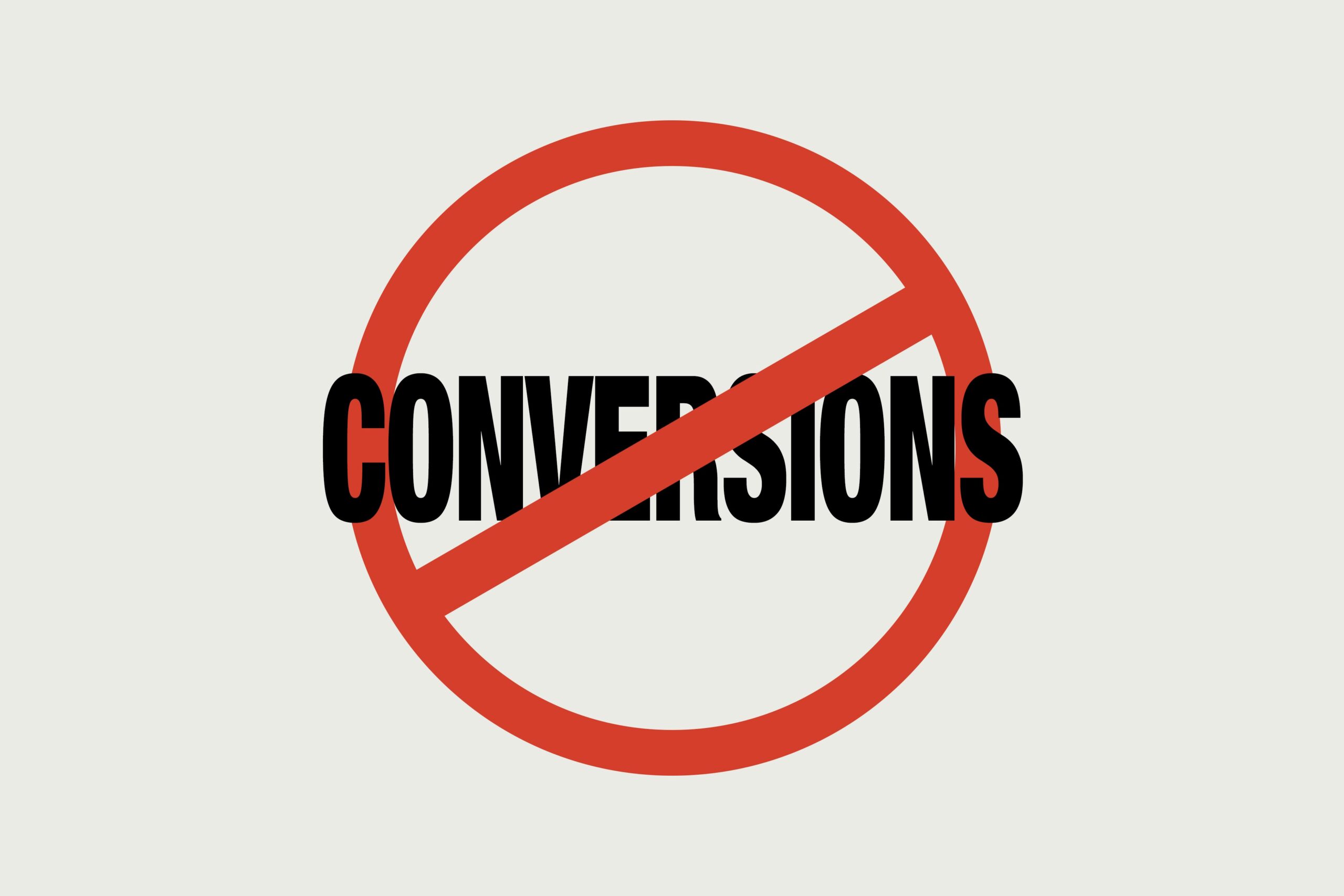
Focusing on conversion rates makes you chase the same types of customers who’ve converted in the past.
Under 2% of your traffic, based on industry research.
This means most ecommerce and marketing teams end up passing over 90%+ of their traffic. For a large brand, that’s potentially millions in untapped sales.
This condition is something we’re calling Conversion Bias Disorder.
These ‘out-of-market’ visitors are your biggest hidden market opportunities. But you have an extremely narrow window to connect these visitors with products of interest.
Why should you care?
Here’s some red flags to look out for:
>> RELYING ON HERO PRODUCT SALES – if most of your revenue comes from a limited number of top-selling products, your merchandising further alienates out-of-market buyers.
>> DOMINANT MARKETING CHANNELS – if you rely on paid marketing to drive most sales, it means you’re not effectively connecting with new audiences who also have a reason to come to your site.
>> LOW PROFIT MARGINS – if you frequently run price discounting and promotions, you quickly erode profitability and cheapen your brand value against competition.
>> STALE INVENTORY – tapping into long-tail products can greatly improve margins and extend reach into new, more profitable audiences.
>> DECREASING TIME ON SITE – with shorter buying sessions and shrinking attention spans, chances traffic connect with products evaporate.
>> LARGE MOBILE REVENUE GAP – mobile buyers have different needs and preferences. They will leave a site that is not tailored to how they want to shop.
Read on to learn how to improve conversions by ignoring conversions. Get inspired by some of the best shopping experiences.
5 ways of increasing Shopify conversion rate by ignoring conversion rates.
1 – Create more jump-off points on your entry pages.
Even though you can’t see your visitors, they all react to your merchandising, and marketing. This reaction is the super-critical stage before a conversion can even happen. We call this customer bond building.
While we don’t want to distract buyers from transacting. Most of your traffic is coming to browse and research. Something gave them a reason to visit. Your entry pages are the place to give them reason to stick around.
A new visitor is missing so much context that you might take for granted. Even the basics. Like who your brand is for and what products it offers. You never get this feedback from shoppers who abandon your site unless you are intentional about seeking it out.
TO DO: Start by analyzing key metrics of the main arrival web pages.
Example: Obviyo’s quadrant chart below (you can also use your Google Analytics) visualizes visitor distribution by key arrival pages.

The bubbles are proportional to the number of visitors arriving on a page. Location of the bubbles is based on visitor bounce rate and revenue per visit rate (RPV). Middle axises represent the average values of those two metrics.
The chart shows you the first experience (bounce rate) and the overall buying experience on your Product Detail and Collection Pages is below average. It needs your attention.
THE ACTION: Surface as many products and collections as possible to create hooks for more engagement.
Example: Take CityGrounds, the hip urban-cycling store. Instead of relying on visitors using collection grid and sorting feature (unlikely) or site search (used by <4% of visitors) they are pro-actively exposing sub-groups of products in the collection (marked by dotted frame). This increases probability visitors will not bounce and engage until they discover product of interest.

2 – Curate relevant products for your core buying personas.
Every Shopify site should be designed with buyer personas in mind. These are your core audiences. But have you thought about how you showcase products for your personas?
It’s typical to see products listed based on the taxonomy of your inventory. And while this gives your site logical structure, it’s not designed for how people shop. It’s designed for how you’ve tagged your stock.
The best brands plan, buy, and merchandise around their core personas. Curating products that are more relevant to visitors than just what’s next, say, alphabetically.
TO DO: Evaluate your key visitor segments
Example: You can group your prospective buyer personas by many attributes. Like source of traffic, prior purchases, brand affinity, etc. Since most visitors are new, it makes sense to start by grouping your visitors by channel.
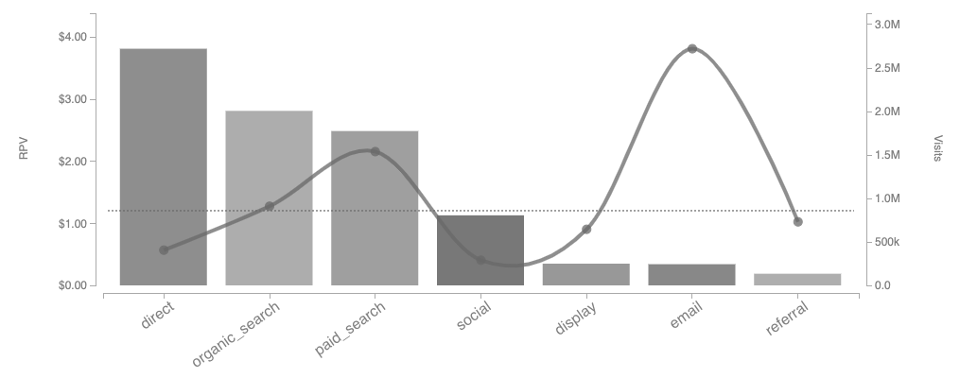
In this Obviyo chart (in your Google Analytics too) shows revenue-per-visit for different marketing channels. It shows you direct, social, and display channels are all underperforming. Delivering more effective product discovery experiences for these channels could improve the metric.
THE ACTION: Curate products for key audiences.
Example: ‘Direct traffic’ usually means returning visitors and customers. NRS World (below) creates relevancy to products visitors have viewed or bought before. It’s one of many ways for engaging with direct traffic to drive more revenue.
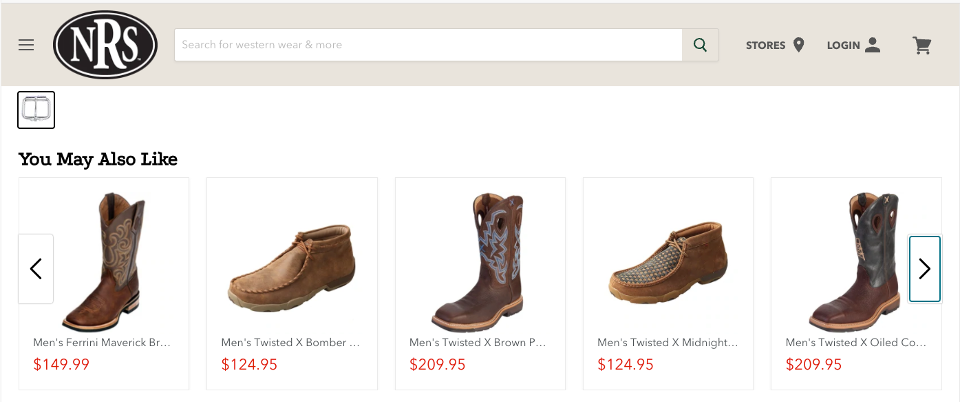
3 – Create greater exposure for your long-tail products (not just your best-sellers).
Every product has its own market. And the job of merchandising your site is to connect products with buyers. Or put another way: the job of your Shopify store is to connect buyers with products of interest.
Focusing only on conversions, biases you towards your best-selling products. The rest of your stock gets neglected and most traffic leaves without discovering anything relevant.
It’s a vicious cycle. A product that does not sell can’t be ranked or recommended. It ends up becoming stale inventory. You have a hard time shifting it.
TO DO: Enrich your product indexes in Shopify admin.
Unleash the power of your products’ meta data. Product name and description, product type, vendor, collections, product tags for styles, affinities, colors, and other intelligence can all drive increased product relevancy. If your ecommerce team creates this data, machine learning algorithms can then act on it.
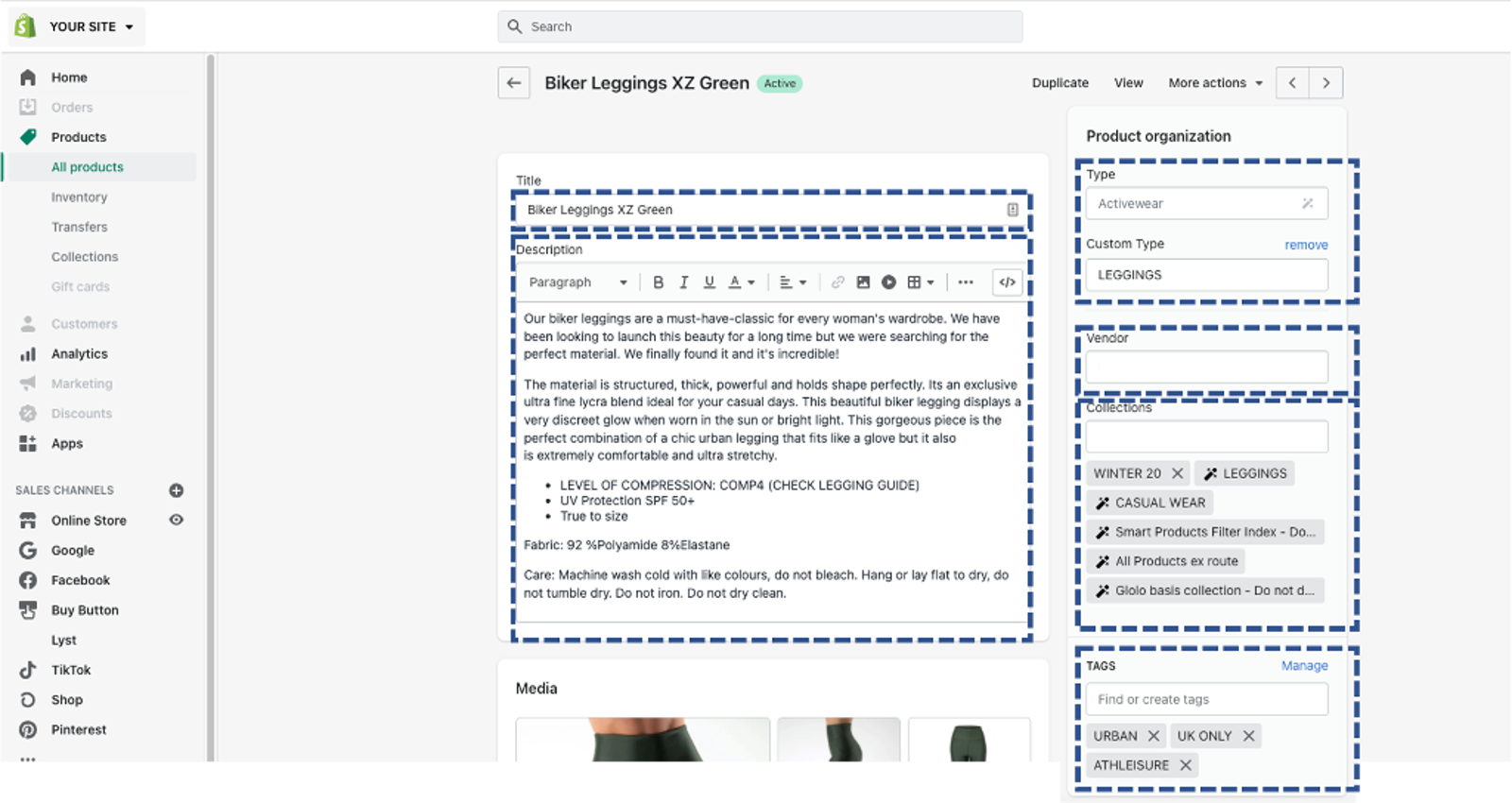
Product index information you will ‘teach’ algorithms to learn similarities among all products. Irrespective if they were ever sold or not. This drives demand for your so-called ‘long-tail’ products. The inventory that is notoriously hard to move. But can greatly expand your profit margins when merchandised right.
THE ACTION: Stage recommendations with use of product meta data indexes.
Example: Genius Books, the specialist independent publisher, takes this to the extreme on their homepage. A new visitor sees a feast of ideas from within their huge catalog, not just best-selling titles.
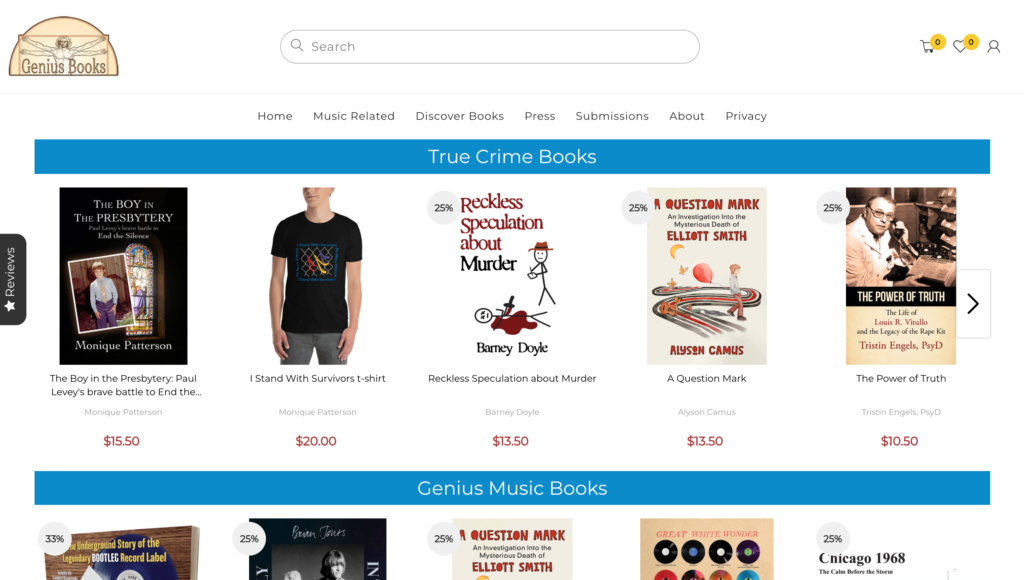
4 – Differentiating your site by blending editorial and product content to create hyper-personalized shopping.
When ecommerce started it was utilitarian. Build it and they will come. Shoppers were amazed with the ability to find a product online, and they bought it.
Then came search – the organizing layer onto top of the web. Also very utilitarian and it helped shoppers easier find a product on the site. Ever since, ecommerce continues to evolve from utility to experience. Away from search and lists to dynamic suggestions and discovery.
The next ecommerce frontier, most vocally promoted by ‘headless’ vendors, is where the intrinsic difference of your brand comes to the front. Combining your editorial content (images, photos, video, etc.) with diverse selections of your products. Your store transforms into an ecosystem of inspiration, connection and discovery. Not just a place to ‘check out’.
TO DO: Compile and organize your assets.
The simplest way for you to manage your assets is to fully leverage Shopify as your content management system. For example, you can use collections feature as a mechanism to store and use your branded content.

There is no limit to how many collections you can have. For each one you can upload a collection image and use Conditions to group products associated with the collection image.
THE ACTION: Blend editorial content with dynamic product lists
The ‘hack’ is to add custom content blocks to your theme. Combining branded images (stored as collection images) with the ordered lists of products generated on the basis of Conditions associated with collection – or some other product filtering criteria. This option requires technical assistance.
A different way is to use a solution like Obviyo. Mix and match custom content from Shopify or content directly uploaded to Obviyo with hyper-personalized product list based on merchant defined Conditions. No coding. In just few motions, you can easily design and publish custom content blocks.
Example: Pat McGrath Labs, one of the most influential and in-demand makeup brands, is blending lifestyle images with curated and personalized product list to inspire, impress, and win new customers.
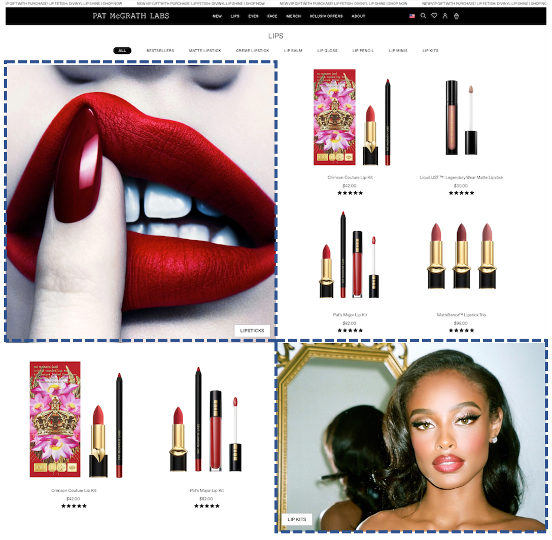
5 – Tapping revenue from existing web visitors, rather than over-paying to acquire new traffic.
Everybody is focused on how bad it is that the average Shopify store has only 1.8% conversion rate. For me, more troubling is the 5.4% average add-to-cart rate.
What does that 5.4% add-to-cart metric really mean? It’s another way of saying 94.6% of visitors never found a product of interest and left.
And 94.6% of your traffic remains completely unknown to you. Whose needs and preferences are total mysteries.
When it comes to paid marketing, you’re faced with increases in marketing spend. It’s like a playing soccer with 94.6% of your team missing – all odds are stacked against you. The cost of paid marketing is going up and your ROI is going down.
Instead of only buying revenue growth I’m evangelizing ways that can unlock the revenue potential from 90% + of visitors who are currently non-buyers.
TO DO: Evaluate paid marketing results.
Example: The chart below compares revenue per visit (RPV) of organic and paid-search traffic. As you’ll see, organic traffic consistently outperforms paid over a 12-month period.
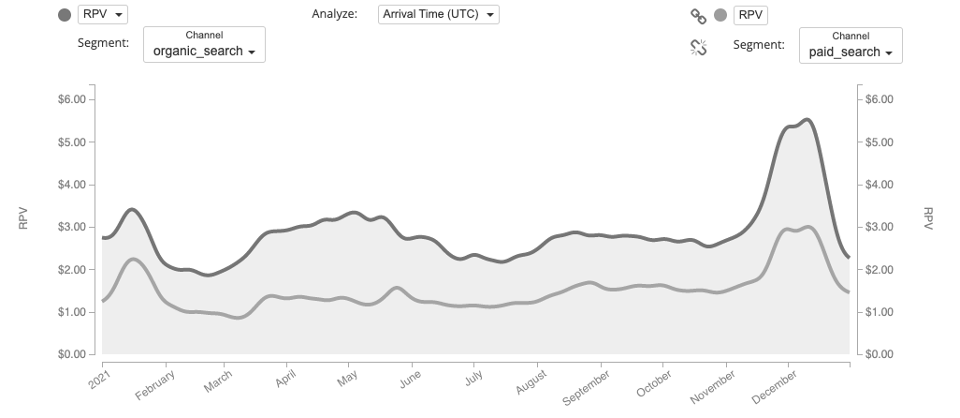
First, to be a viable source of traffic paid-search RPV should be 2–3x higher than PPC (pay per click). Second, as a rule of thumb, paid-search should outperform the organic traffic. This type of analysis should guide your budget allocation on paid-search.
THE ACTION: Unlock revenue potential from current non-buyers (90%+ of your traffic).
Amazon’s machine learning team discovered visitors’ live-actions and context are much better predictor of needs and preferences than historical purchase data alone.
This is game changing technology. Making it possible to bond with current non-buying visitors and unlock new revenue. This was the main reason we partnered with Amazon and build Obviyo’s Shopify solution to leverage these new AI capabilities.
Example: Laura James, a leading UK furniture brand, uses real-time product recommendations to assist visitors with better product discovery.
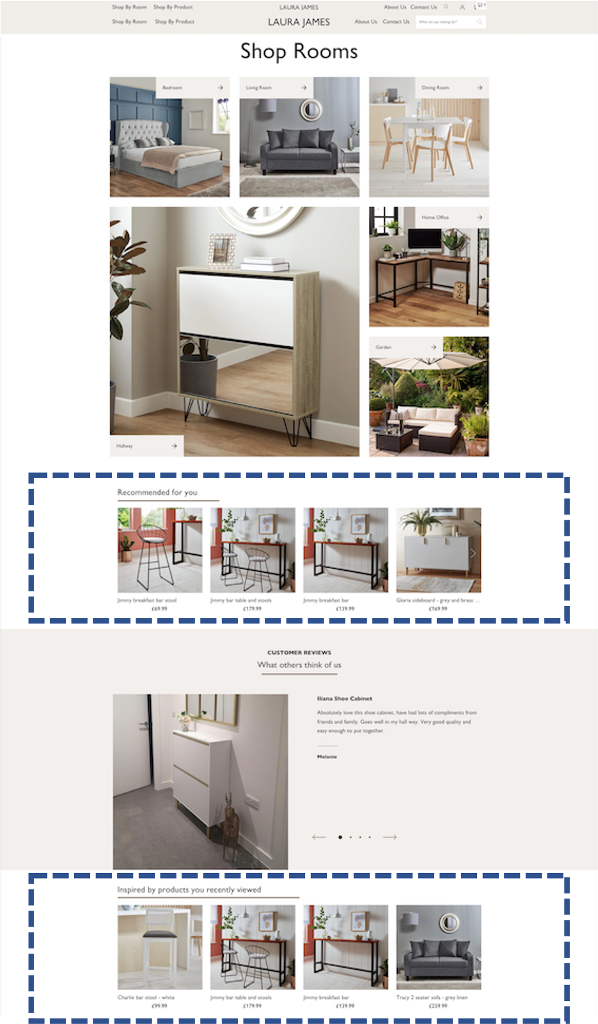
‘Recommended for you’ and ‘Inspired by products you recently viewed’ are hyper-personalized suggestions, guided by each visitor’s live actions and context.
How to see 100% Shopify conversion rate difference in 7-days with customer bonds.
The common theme of any of the ‘5 Ways’ above is adding new content blocks to your Shopify site. With the mission to drive engagements with different types of visitors having different product needs and affinities.
We call this customer bond building.
We encourage you to follow the steps above and start adding and strengthening your customer bonds. Get going with the tools and resource you have at your disposal now.
Or, we invite you to test drive Obviyo for Shopify. It enables customer bond building for all ecommerce and marketing teams. No-coding required.
7-day ‘Conversion Detox’ offer:
A complimentary, ‘done-for-you’, test of Obviyo for Shopify.
1. You install Shopify app
Start on Shopify app store then activate from your Shopify admin panel.
2. We initiate your Customer Bond Building routine
Our services team will select and provision 4-6 bond building HyperBlocks™, hyper-personalized content, on your site. Before going live, you’ll review and approve the setup. Once live, your 7-day clock starts ticking.
3. You review results
We’ll meet after at least 7-days of live Customer Bond Building. By then you’ll have enough results and experience to decide if bond building is valuable for your brand.



